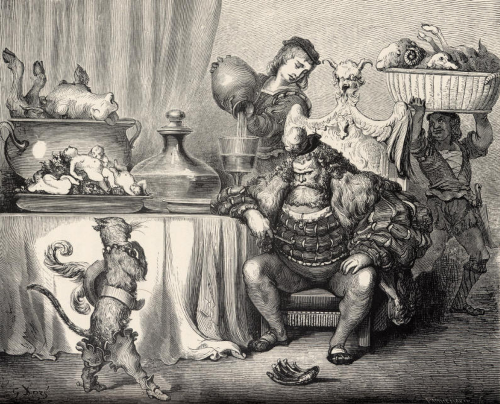 |
| Art by Gustave Doré |
The second edition of Monsters! Monsters! is now available. Technically, the second edition was available forty-one years ago. The subject of this post is the second, second edition which – in a more prosaic numbering scheme – would be the third edition. According to the introduction, this version of Monsters! Monsters! (hereinafter M!M! ) stemmed from Ken St. Andre's desire “to get Toughest Dungeon in the World back into print...” Since that adventure was intended for trolls, St. Andre believed it should be reprinted for M!M! rather than as a Tunnels & Trolls product. Of course, the most recent version of M!M! was four decades old. As such, the new Toughest Dungeon should include a set of M!M! mini-rules. Instead, the development of those mini-rules blossomed into a full-fledged product.
Given that M!M! is compatible with Tunnels & Trolls (hereinafter T&T ), the rules are very similar. The differences, however, are interesting. In T&T, the default system for determining primary attribute values is to roll 3d6 for for each attribute in order. In M!M!, players assign rolled values to attributes as they see fit. Because attribute modifiers for monsters are more extreme than the usual T&T player character kindred, assigning attribute values can be especially effective.
Primary attributes are not described, but Charisma can cause “regular humanoid kindred” to react in different ways depending upon the symbol associated with a monster's Charisma on the “Monster Character Modifier Table” on pages 20 and 21.
☠ = terror (Example monsters include Balrukh, Dragon, and Obsidian Spider)
! = some fear (Example monsters include Yeti, Dire Wolf, and Mummy)
? = indicates surprise or disgust (Example monsters include Living Skeleton, Harpy, and Giant-Slug)
🖤 = awe or liking (Example monsters include Griffin and Unicorn)
There are five kindred for use in a “Fast Start” game of M!M! : Flesh Trolls, Dhesiri (Lizardmen), Uruks (Orcs), Hrogrs (Ogres), and Gremlins. Attributes are modified by fixed amounts. For instance, Lizardmen have +10 Strength (STR), +10 Constitution (CON), +4 Dexterity (DEX), +4 Luck (LK), –3 IQ, and –5 Charisma (CHR). For M!M! games that aren't “Fast Start,” there are 49 monsters listed on the “Monster Character Modifier Table.” Attribute modifiers on the table are expressed in multiples. The modifiers for Lizardmen are STR × 1.75, CON × 1.75, DEX × 1, CHR × .75 , IQ × .75, LK × 1, and Wizardry (WIZ) × 1. So, +4 DEX, +4 LK in “Fast Start,” translates as no modifier in the table. Furthermore, the Lizardmen modifiers are different from those in the Deluxe Tunnels & Trolls (dT&T ) Peters-McAllister Chart. According to that chart, Lizard People have LK × .75, WIZ × .75, and CHR × 1.25. The rules do not explain these inconsistencies. This is just one example.
Each kindred in M!M! as a special ability not necessarily reflected in dT&T . Lizardmen have an amount of armored skin based on their level; Gremlins reduce by 25% the Luck of non-Gremlins within ten feet.
Monsters can enter “Beast Mode” at will. Although this is described as “berserk,” Beast Mode is handled differently than Berserk Combat in dT&T. In Beast Mode, player characters “no longer use their normal stats but instead use their converted MR and attack twice every combat round.” MR is Mankind Rating (or Monster Rating) and, “A Humanoid's CON = Mankind Rating...” This phrase suggests that non-humanoid MR is derived differently, but this is not addressed in the rules. Beast Mode 'costs' four points of MR for the first round and the cost doubles every round thereafter. Beast Mode lasts until MR is depleted (which causes unconsciousness) or no friend or enemy is present within twenty feet.
Once character generation and combat is explained, the remainder of the rules fall under a section called “How To Be A Better Monster,” including such things as saving rolls and adventure points. An optional rule called Chaos Factor is also included. Chaos Factor equals a monster's level and “represents the forces in... nature that spread misfortune, bad luck, and ill omens throughout the land.” Once per turn, a monster can add or subtract its Chaos Factor to or from any one roll. Monsters can learn spellcasting, but in so doing they lose their Chaos Factor. Monsters who are not spellcasters really have no need of the Wizardry attribute. Perhaps, instead of a monster's level, Chaos Factor could equal Wizardry.
Speaking of spells, M!M! offers five pages of spells. Some monsters inherently know certain spells; most Sphinxes know the Divine Disapproval spell and Gorgons know the Medusa spell. Unfortunately, these spells are not described in M!M! It is unrealistic to expect M!M! to include all the dT&T spells, but it should at least include all of the spells it references. After all, the introduction says dT&T “really isn't necessary for you to get into this RPG.”
The original M!M! described fifty-two monsters. One could use a deck of cards to randomly select a monster. As indicated above, the new version of M!M! describes forty-nine monsters. Why not include three additional monster kindred and asign a card to each? There are various possibilities. The description for Stingaree begins with, “Often confused with the common manticore...“ However, manticores are not among the 49 described kindred. Strangely, manticores are included on an encounter table for the adventure included with M!M! Another encounter table has a Deathfrog: “Large, the size of a rhinocerous [sic], green, warty, with a long prehensile tongue that strikes with the force of a whip, sharp teeth that can bite through iron, and powerful hind legs.” Some monsters from dT&T that could easily have been part of M!M! include Redcaps, Keeraptora (winged humanoids), and Ghouls.
